
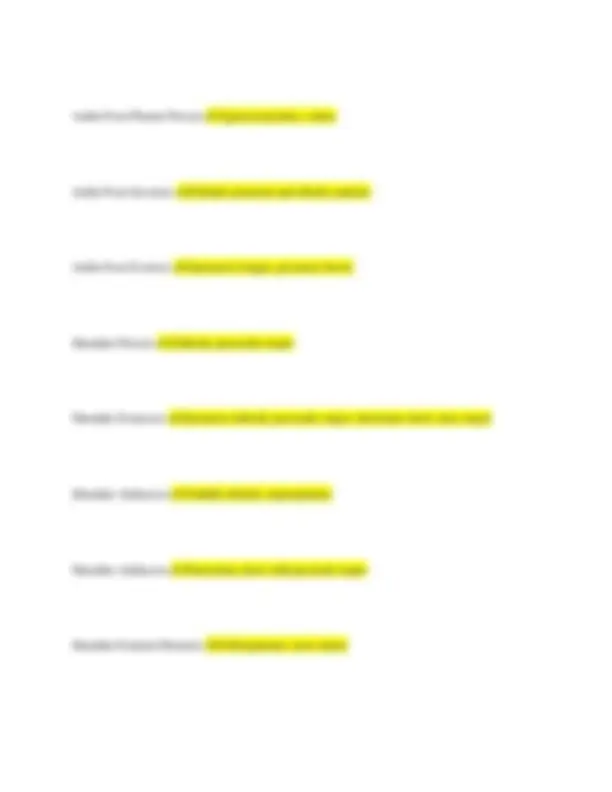
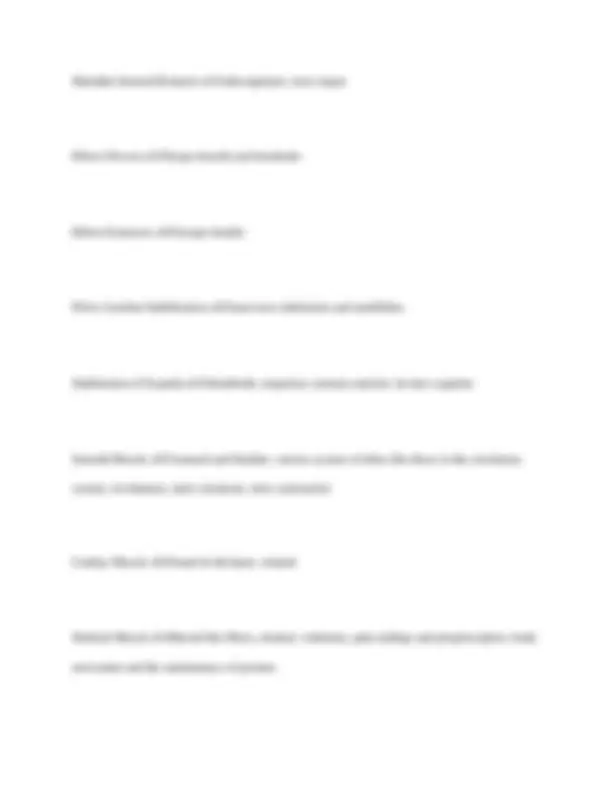
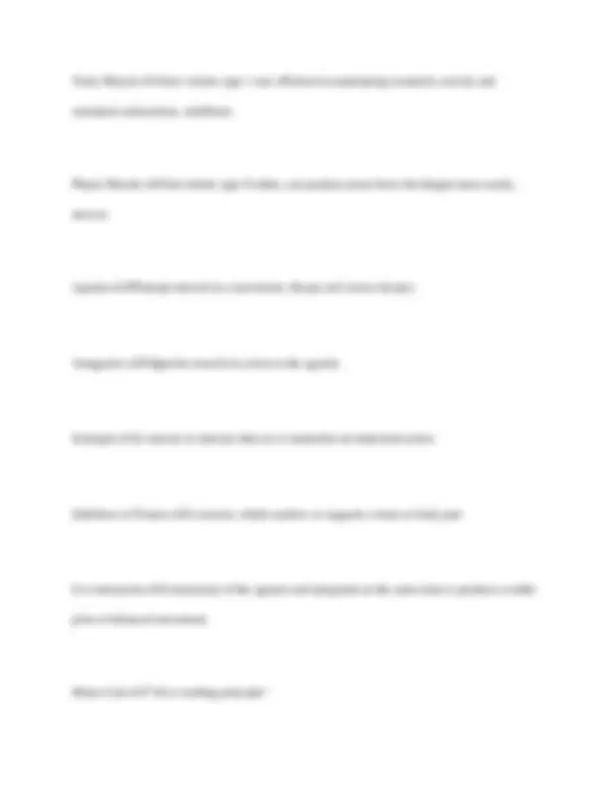
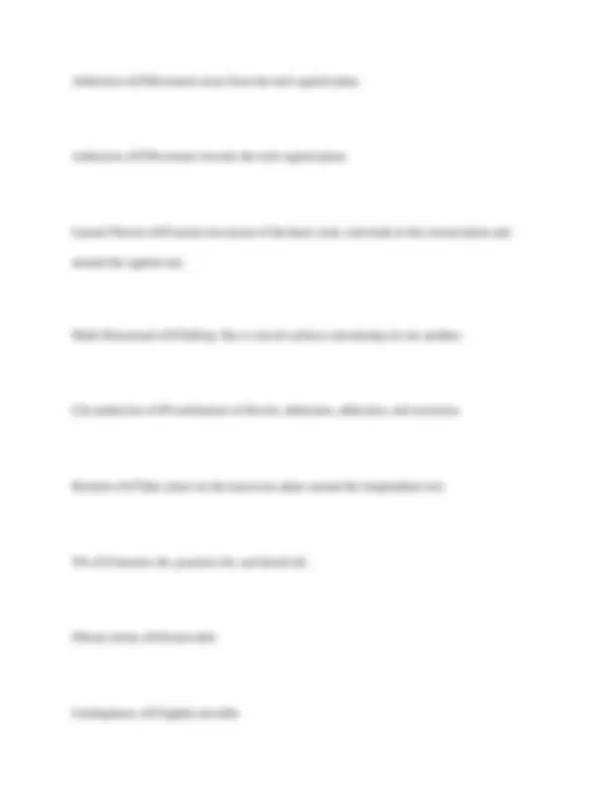
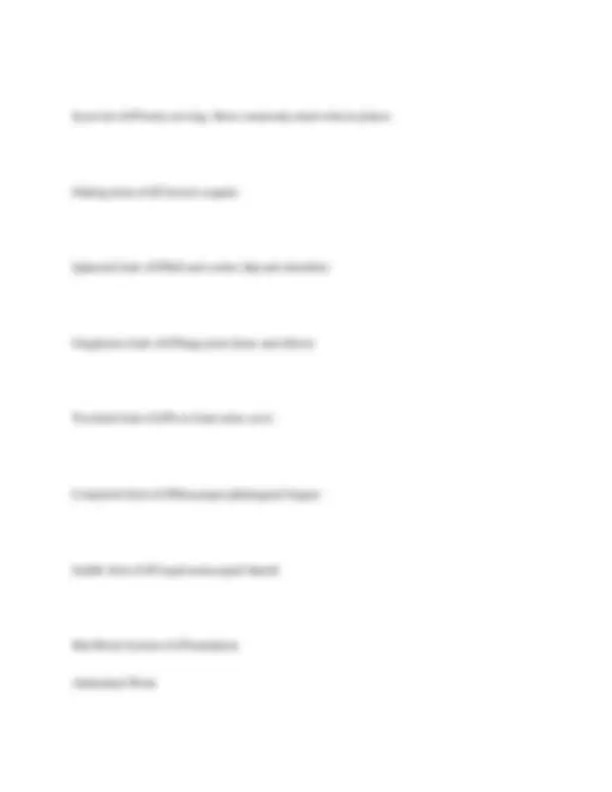
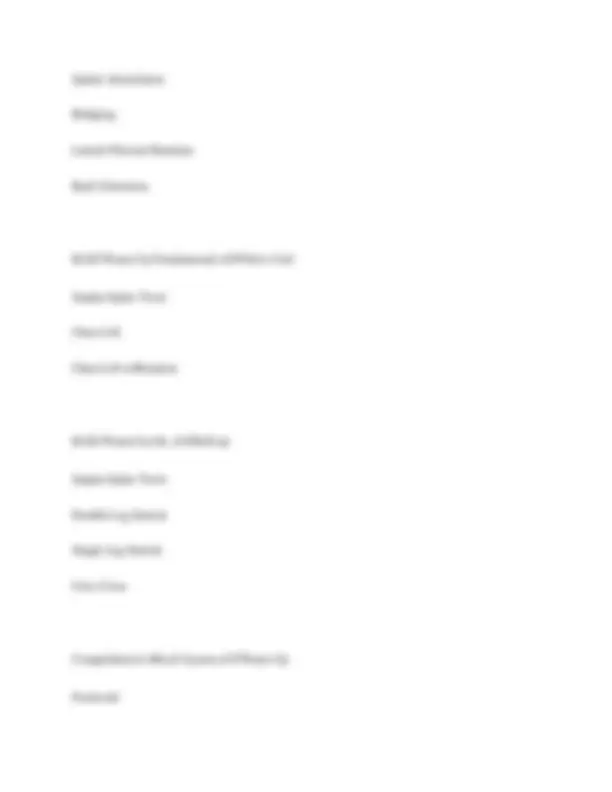
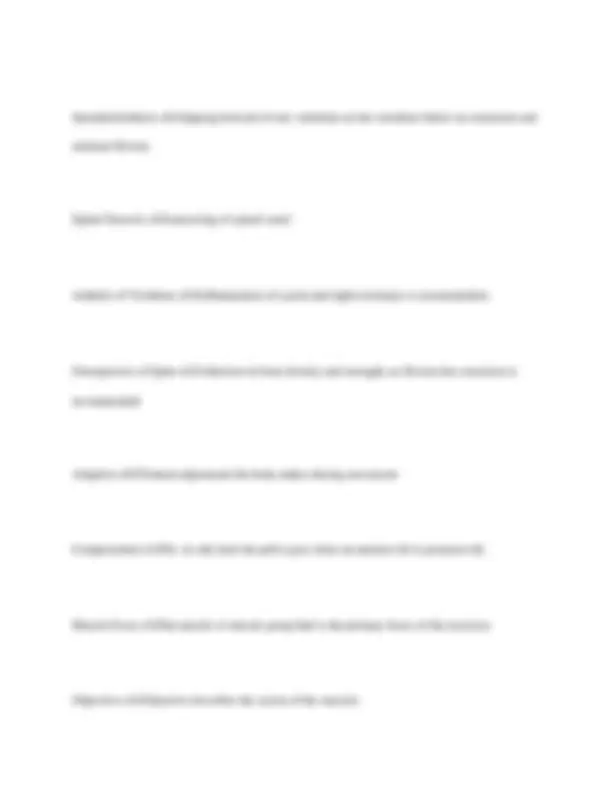
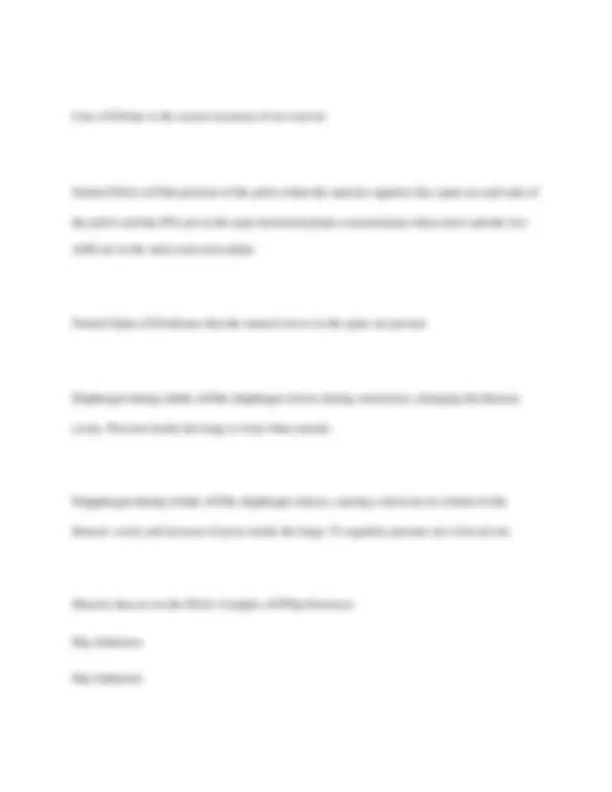
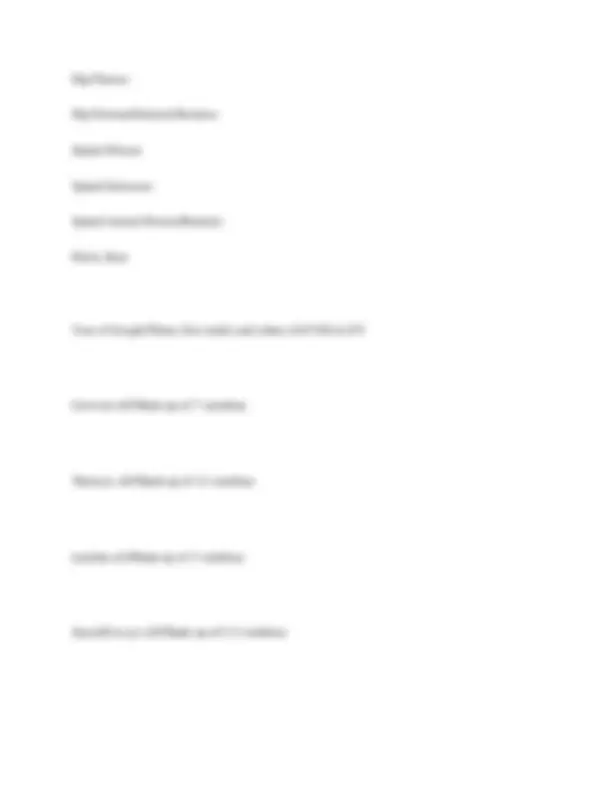
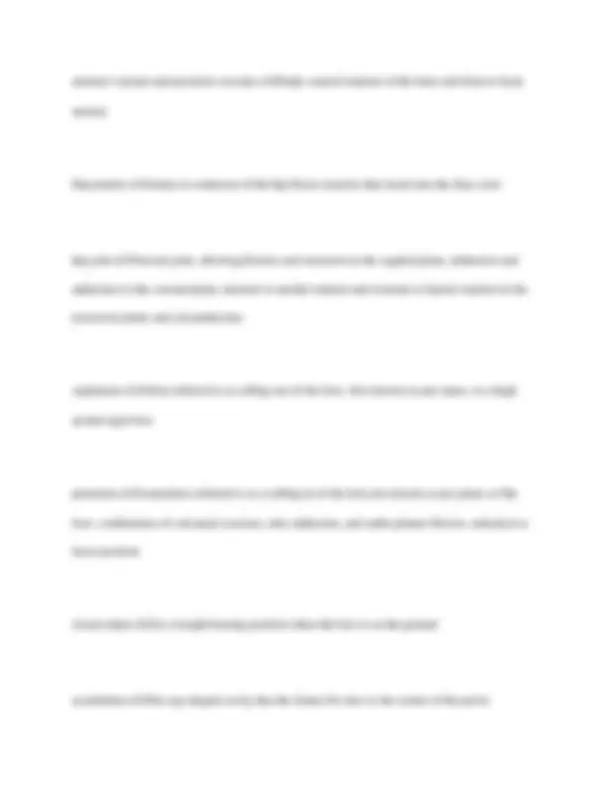
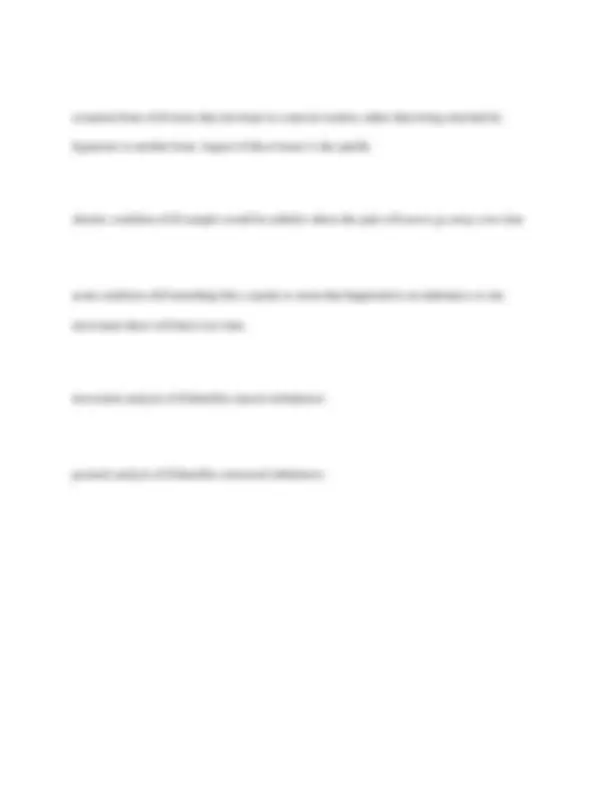


Study with the several resources on Docsity

Earn points by helping other students or get them with a premium plan


Prepare for your exams
Study with the several resources on Docsity

Earn points to download
Earn points by helping other students or get them with a premium plan
Community
Ask the community for help and clear up your study doubts
Discover the best universities in your country according to Docsity users
Free resources
Download our free guides on studying techniques, anxiety management strategies, and thesis advice from Docsity tutors
A comprehensive study guide or reference material for the basi (body arts and science international) final exam. It covers a wide range of topics related to human anatomy, physiology, and kinesiology, including detailed information on the various muscle groups, joint movements, and biomechanical principles. The document also includes questions and answers on pilates-specific concepts, exercises, and equipment. This resource could be highly valuable for students preparing for the basi final exam, as it provides a thorough review of the key topics and concepts that are likely to be tested. The level of detail and the breadth of coverage suggest that this document could also be useful for pilates instructors, physical therapists, or anyone interested in a deeper understanding of the human body and movement.
Typology: Exams
1 / 19

This page cannot be seen from the preview
Don't miss anything!












Spine Flexors ✔✔Rectus Abdominis, External Oblique, Internal Oblique
Spine Extensors ✔✔Erector Spinae (longissimus, iliocostalis, spinalis)
Spine Lateral Flexors ✔✔External Oblique, Internal Oblique, Quadratus Lumborum, Erector Spinae (logissimus, iliocostalis, spinalis)
Spine Rotators ✔✔Internal and External Oblique, Erector Spinae(longissimus, iliocostalis, spinalis)
Hip Flexors ✔✔Iliospoas, Rectus Femoris, Sartorius
Hip Extensors ✔✔Gluteus Maximus, Hamstrings (semimembranosus, semitendinosus, and biceps femoris)
Hip Abductors ✔✔Gluteus Medius, Gluteus Minimus, Tensor Fasciae Latae, Sartorius, upper ranges of the iliopsoas and pirformis
Hip Adductors ✔✔Adductor Longus, Adductor Brevis, Adductor Magnus, Gracilis, and Pectineus
Hip External Rotators ✔✔Gluteus Maximus, Posterior Fibers of Gluteus Medius (when hip is flexed), Sartorius, Biceps Femoris and deep outward rotators (piriformis, obturator interns, obturator externus, quadratus femoris, gemellus superior and gemellus inferior)
Hip Internal Rotators ✔✔gluteus medius (anterior fibers), gluteus minimus, tensor fasciae latae, piriformis, semtendinousus, semimembranosus
Knee Flexors ✔✔Hamstrings (semimembranosus, semitendinosus, biceps femoris)
Knee Extensors ✔✔quadriceps femoris: vastus medialus, vastus intermedius, vastus lateralis, rectus femoris
Ankle-Foot Dorsiflexors ✔✔Tibialis anterior, extensor digitorum longus
Shoulder Internal Rotators ✔✔subscapularis, teres major
Elbow Flexors ✔✔biceps brachii and brachialis
Elbow Extensors ✔✔triceps brachii
Pelvic Lumbar Stablilzation ✔✔transverse abdominis and multifidus
Stablization of Scapula ✔✔rhomboids, trapezius, serratus anterior, levator scapulae
Smooth Muscle ✔✔stomach and bladder, various system of tubes like those in the circulatory system, involuntary, lacks striations, slow contraction
Cardiac Muscle ✔✔found in the heart, striated
Skeletal Muscle ✔✔thread-like fibers, striated, voluntary, pain endings and proprioceptors, body movement and the maintenance of posture
Tonic Muscle ✔✔slow twitch, type 1 red, efficient in maintaining isometric activity and sustained contractions, stabilizers
Phasic Muscle ✔✔fast twitch, type ll white, can produce more force but fatigue more easily, movers
Agonist ✔✔Principe muscle in a movement. (bicep curl versus triceps)
Antagonist ✔✔Opposite muscle in action to the agonist
Synergist ✔✔a muscle or muscles that act to neutralize an undesired action
Stabilizer or Fixator ✔✔a muscle, which anchors or supports a bone or body part
Co-contraction ✔✔contraction of the agonist and antagonist at the same time to produce a stable joint or balanced movement
Motor Unit ✔✔"all or nothing principle"
Transverse Plane ✔✔Divides the body into upper and lower.
Sagittal Axis/ Anteroposterior ✔✔Extends from the from to the back and abduction-adduction occurs around it.
Coronal Axis/ Mediolateral ✔✔Extends from side to side. Flexion and extension occurs around it.
Longitudinal Axis/ Vertical Axis ✔✔Top to bottom/ medial-lateral. Rotation occurs around it.
Flexion ✔✔Movement in an anterior direction for the upper extremities and hip joint and movement in a posterior direction for the lower extremities.
Extension ✔✔Movement in the direction opposite flexion.
Hyperextension ✔✔Excessive movement/ position in the direction of extension.
Abduction ✔✔Movement away from the mid-sagittal plane.
Adduction ✔✔Movement towards the mid-sagittal plane.
Lateral Flexion ✔✔Lateral movement of the head, neck, and trunk in the coronal plane and around the sagittal axis.
Multi Directional ✔✔Gliding: flat or curved surfaces articulating on one another.
Circumduction ✔✔Combination of flexion, abduction, adduction, and extension.
Rotation ✔✔Takes place on the transverse plane around the longitudinal axis.
Tilt ✔✔Anterior tilt, posterior tilt, and lateral tilt
Fibrous Joints ✔✔immovable
Cartilaginous ✔✔slightly movable
Spinal Articulation
Bridging
Lateral Flexion/ Rotation
Back Extension
BASI Warm-Up Fundamental ✔✔Pelvic Curl
Supine Spine Twist
Chest Lift
Chest Lift w/Rotation
BASI Warm-Up Int. ✔✔Roll-up
Supine Spine Twist
Double Leg Stretch
Single Leg Stretch
Criss Cross
Comprehensive Block System ✔✔Warm-Up
Footwork
Abdominal Work
Hip Work
Spinal Articulation
Stretches
Full Body Integration (F/I)
Arm Work
Full Body Integration (A/M)
Leg Work
Lateral Flexion/ Rotation
Back Extension
Features unique to pilates are ✔✔unsafe because it does not stabilize the user
First Phase of Up Stretch 2 ✔✔Back extensors
Knee Stretch Group ✔✔Scooter
Knee Stretch Round Back
Knee Stretch Flat Back
Spondylolisthesis ✔✔slipping forward of one vertebrae on the vertebrae below no extension and minimal flexion
Spinal Stenosis ✔✔narrowing of spinal canal
Arthritis of Vertebrae ✔✔inflammation of a joint and light resistance is recommended.
Osteoperosis of Spine ✔✔reduction in bone density and strength, no flexion but extension is recommended
Adaption ✔✔Normal adjustment the body makes during movement
Compensation ✔✔Ex. in side kick the pelvis goes from an anterior tilt to posterior tilt
Muscle Focus ✔✔the muscle or muscle group that is the primary focus of the exercises
Objectives ✔✔objective describes the action of the muscles
Cues ✔✔relate to the actual execution of an exercise
Neutral Pelvis ✔✔the position of the pelvis when the anterior superior iliac spine on each side of the pelvis and the (PS) are in the same horizontal plane (coronal plane when erect) and the two ASIS are in the same transverse plane.
Neutral Spine ✔✔indicates that the natural curves in the spine are present.
Diaphragm during inhale ✔✔the diaphragm lowers during contraction, enlarging the thoracic cavity. Pressure inside the lungs is lower than outside.
Diapghragm during exhale ✔✔the diaphragm relaxes, causing a decrease in volume of the thoracic cavity and increase of press inside the lungs. To equalize pressure air is forced out.
Muscles that act on the Pelvic Complex ✔✔Hip Extensors
Hip Abductors
Hip Adductors
Four actions of the Latissimus Dorsi ✔✔Adduction of the shoulder, internal rotation of the shoulder, flexion from an extended position, and horizontal abduction
Push Through Group ✔✔Saw, Sitting Forward, Sitting Back, Side Reach, Kneeling Cat Stretch, Side Lift
Flexibility ✔✔range of motion associated bones, and bony structures, muscles, tendons, ligaments, genetics, temperature, and neural factors influence this
Overload Principle ✔✔to achieve the desired improvement the relevant body systems must be progressively and gradually stressed to their limits
The Principle of Specificity ✔✔Adaptions occur due to the muscles that are being overloaded
SAID Prinicple ✔✔When the appropriate overload is applied the body adapts specifically to the type of overload and the manner in which it is applied.
The Priniciple of Reversibility ✔✔If overload is discontinued or decreased, detaining and a decrement in performance will occur
Muscular Strength ✔✔Capacity to exert force against resistance in a single effort. Few number of reps (6-12). High load/resistance.
Muscular Endurance ✔✔Ability to repeatedly produce force against a given resistance. Higher number of reps (8-12). 2-3 minutes of recovery. Putting exercises in consecutive order.
Rotator Cuff ✔✔Essential for providing shoulder stability and facilitating subtle desired mechanics of the shoulder. Comprised of supraspinatus, subscapularis, infraspinatus and teres minor.
Sternoclavicular Joint ✔✔The only bony attachment of the upper extremities to the axial skeleton via the clavicle.
Scapulohumeral Rhythm ✔✔The coordinated movement of the shoulder girdle that provides correct mechanics.
medial collateral and lateral collateral ligaments ✔✔prevent the knee from going side to side
sesamoid bone ✔✔a bone that develops in a muscle tendon, rather than being attached by ligaments to another bone. largest of these bones is the patella
chronic condition ✔✔example would be arthritis where the pain will never go away over time
acute condition ✔✔something like a sprain or strain that happened to an imbalance or one movement these will heal over time.
movement analysis ✔✔identifies muscle imbalances
postural analysis ✔✔identifies structural imbalances